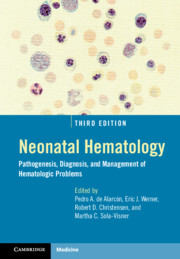Book contents
- Neonatal Hematology
- Neonatal Hematology
- Copyright page
- Contents
- Foreword
- Preface
- Contributors
- Section I Developmental Hematology
- Section II Bone Marrow Failure and Immune Disorders
- Section III Erythrocyte Disorders
- Section IV Platelet Disorders
- Section V Leucocyte Disorders
- Section VI Hemostatic Disorders
- Section VII Neonatal Transfusion Medicine
- Section VIII Neonatal Oncology
- Section IX Miscellaneous
- Index
- Plate Section (PDF Only)
- References
Section VI - Hemostatic Disorders
Published online by Cambridge University Press: 30 January 2021
- Neonatal Hematology
- Neonatal Hematology
- Copyright page
- Contents
- Foreword
- Preface
- Contributors
- Section I Developmental Hematology
- Section II Bone Marrow Failure and Immune Disorders
- Section III Erythrocyte Disorders
- Section IV Platelet Disorders
- Section V Leucocyte Disorders
- Section VI Hemostatic Disorders
- Section VII Neonatal Transfusion Medicine
- Section VIII Neonatal Oncology
- Section IX Miscellaneous
- Index
- Plate Section (PDF Only)
- References
Summary
Bleeding symptoms presenting in the neonatal period usually present a diagnostic and therapeutic challenge for treating physicians. Bleeding disorders may be due to either congenital or acquired coagulation disorders, and may be related to mortality or long term morbidity when not appropriately and timely diagnosed. While severe congenital coagulation defects usually present in the first hours to days of life with distinct symptoms in otherwise well newborns, acquired coagulation disorders usually present in sick newborns with a variety of presentations and distinct etiologies that differ from older children and adults. In newborns, the diagnosis of coagulation abnormalities based upon plasma concentrations of components of the hemostatic system requires age-appropriate reference ranges because plasma concentrations of several procoagulant and inhibitor proteins are physiologically decreased at birth. The aim of this chapter is to discuss clinical presentation, diagnosis, and management of the most common congenital and acquired bleeding disorders in newborns, excluding platelet disorders.
- Type
- Chapter
- Information
- Neonatal HematologyPathogenesis, Diagnosis, and Management of Hematologic Problems, pp. 293 - 328Publisher: Cambridge University PressPrint publication year: 2021



